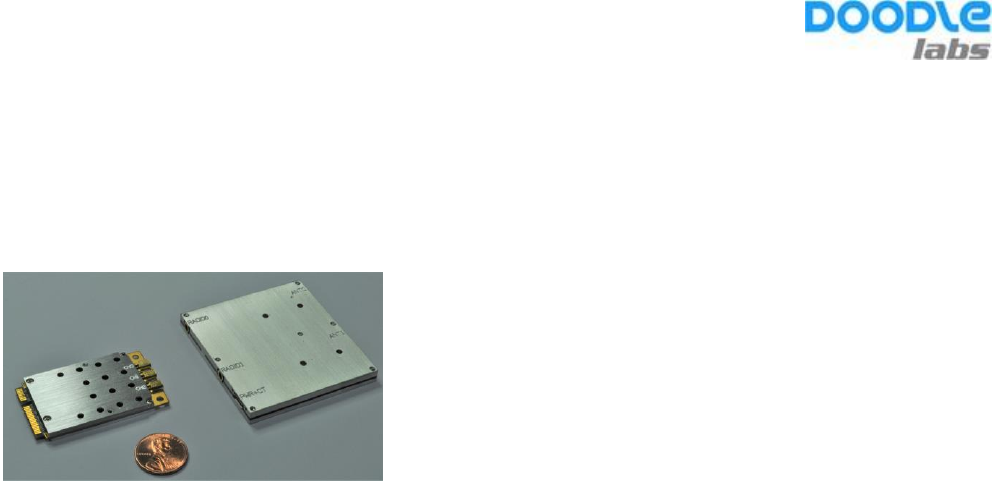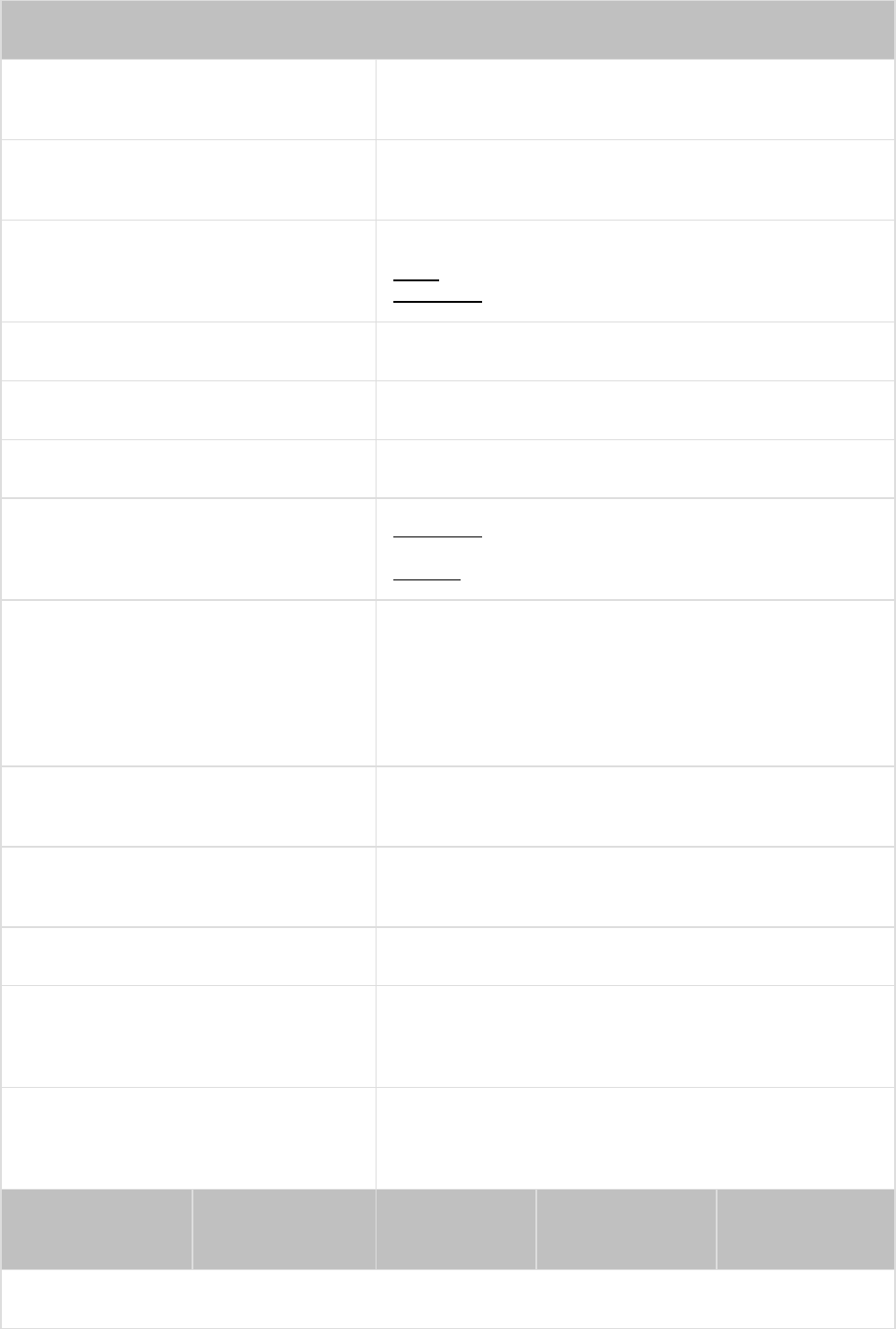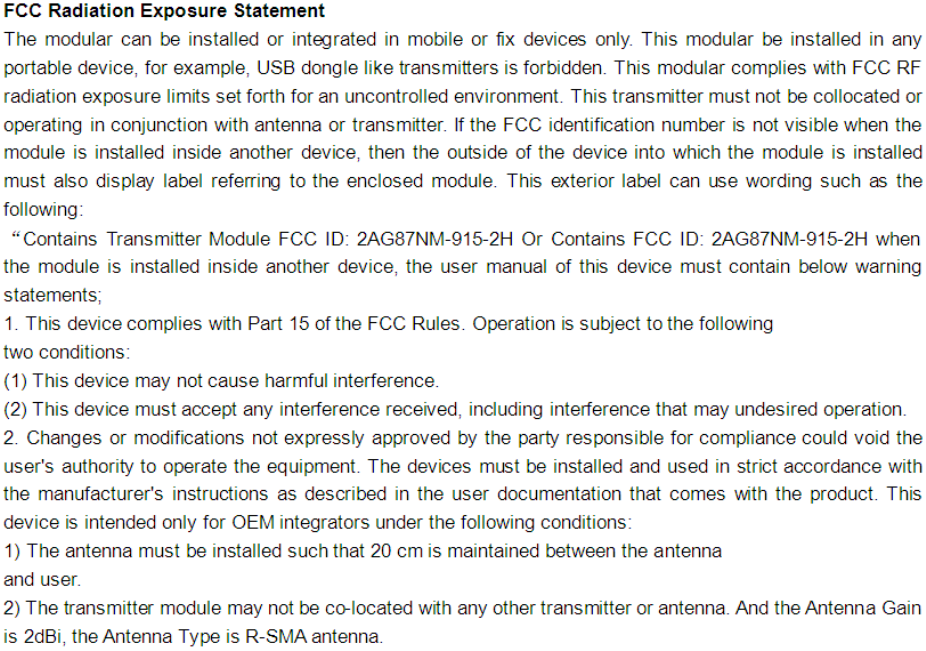Doodle Labs NM-915-2H Prism Wi-Fi Radio Transceiver User Manual
Doodle Labs (SG) Pte Ltd Prism Wi-Fi Radio Transceiver
User Manual

NM-915-2H
900 MHz, Rugged, Long Range 2 Stream Broadband Radio Transceiver
Features
• 2 stream option to maximize data throughput
• 30 dBm of RF power to push downstream data at higher modulation rates
• Integrated LNA for best-in-class Rx sensitivity
• High Q band pass filters provide interference immunity from strong Pager/GSM signals in the
neighbouring 900 MHz bands
• Supports 5 MHz channels to maximize spectrum efficiency
• AP and STA modes to implement Point to Point, Infrastructure Point to multi Point, and Ad-
hoc/Mesh networks
• High wireless data security with up to 128 bit AES encryption
• Dynamic Link adaptation to optimize throughput depending on channel conditions
• Modular architecture allows a variety of mounting and heat management possibilities.
• Reliable design for outdoor and vehicular environments. MMCX connectors, Electrical Stress
protection, -40°C to +85°C operating environment.
• Supports spatial multiplexing, cyclic-delay diversity (CDD), low-density parity check (LDPC),
maximal ratio combining (MRC), Space Time Block Code (STBC)
Target Applications
The NM-915-2H, Long range transceiver is ideal for applications that require operation in rugged
environments, medium data throughput with deep penetration through walls and tree/vegetation.
• HD Video streaming from UAV/Drones

TECHNICAL SPECIFICATIONS
Model No. NM-915-2H (Rugged, Long Range applications, 802.11n,
ath9k driver)
MAC Chipset Qualcomm Atheros
QCA9590-BR4B with Extended Temperature range
Software Support
Open Source Linux Drivers
ath9k for 11n models
OpenWRT (Wireless Router/Linux OS)
Center Frequency Range 902 MHz ~ 928 MHz
Channel Bandwidth* 5 MHz
Radio Modulation (Auto Adjust) CCK, BPSK, QPSK, 16 QAM, and 64 QAM
Data Rates Supported
802.11 b/g: 1, 2, 5.5, 6, 9, 11, 12, 18, 24, 36, 48 and 54
Mbps (2.4 GHz)
802.11n: MCS0-15
802.11n version 2.0 Capabilities
Packet aggregation: A-MPDU (Tx/Rx), A-MSDU (Tx/Rx),
Maximal ratio combining (MRC), Cyclic shift diversity
(CSD), Frame aggregation, block ACK, 802.11e
compatible bursting, Spatial multiplexing, cyclic-delay
diversity (CDD), low-density parity check (LDPC), Space
Time Block Code (STBC)
Operating Modes AP, STA and Adhoc modes to implement Point to Point,
Point to multi Point, and Mesh networks
MAC Protocol TDD with Carrier Sense Multiple Access with Collision
Avoidance (CSMA/CA)
Wireless Error Correction FEC, ARQ
Wireless Data Security
128 bit AES, WEP, TKIP and WAPI hardware encryption.
Support for IEEE 802.11d, e, h, i, k, r, v, w and time stamp
standards
FIPS Certification
Loop back mode to facilitate FIPS AES certification, Small
packet size (96 bytes) in AES encryption at full packet
rate
Tx/Rx
Specification Radio
Modulation Coding Rate Tx Power
(±2dBm)** Rx Sensitivity
(Typ)
5 MHz Channel

802.11n
BPSK
1/2
27
-98
802.11n
16 QAM
3/4
27
-89
802.11n
64 QAM
3/4
21
-82
* It is advantageous to use the smallest Channel Bandwidth that can support the Throughput
requirements. Smaller bandwidths provide more channels to choose and help avoid interference issues.
The system’s SNR is higher at smaller Channel Bandwidths and Range is longer.
Antenna Signal Strength
-35 to -85 dBm (Recommended), Absolute Maximum=+12
dBm
Receiver LNA Gain
>10 dB
Receive chain Noise Figure
6 dB
RF Power control by Driver
In 0.5 dBm steps. Accuracy of power calibration loop ±2
dBm. Each transceiver individually calibrated and
tested.
RF Hardware Disable (RF Kill)
Pin 20 of miniPCI-E interface. (Required for FAA
compliance)
Control for External Power Amp
Available as an optional configuration
Receiver Adjacent Channel Rejection
(ACR)
>18 dB @ 11a, 6 Mbps (Typ)
Receiver Alternate Channel Rejection
(ALCR)
>35 dB @ 11a, 6 Mbps (Typ)
Transmitter Adjacent Channel Leakage
power Ratio (ACLR)
45 dB (Fc ± ChBW)
Transmitter Spurious Emission
Suppression
-40 dBc
PHYSICAL, ENVIRONMENTAL AND OTHER SPECIFICATIONS
Antenna Ports
2 Ports (50 Ohms) with MMCX connectors
Integrated Antenna Port Protection
>20 KV (Human Body Model)
Host Interface
miniPCI-Express 1.2 Standard

Host CPU Board
Any CPU board with Industry standard miniPCI-Express
interface with minimum 6 mm connector height
Operating Voltage
3.3 Volts from miniPCI-E interface for radio
6~42V for FES
Power Consumption
Total 6W (4W @ Max power for FES + 2W for radio
module) in data transfer mode
Total 2.5W (1.3W for FES + 1.5W for radio module) in
data receive mode
Shield case temperature range
(Operating)
-40°C to +85°C (Rugged, Long range NM-915-1G model)
The System’s thermal design should ensure that the
transceiver’s shield case temperature is maintained within
these specifications.
Prism-FES can be mounted away from the host CPU
board for better thermal design
Cable Assembly
Assembly drawing available upon request. (Includes the
harness with RF cable and DC power for initial samples)
Dimensions
1x 30 x 50 x 6 mm Radio module, 1x 60 x 56 x 6 mm FES
module, Total 54 grams (1×14 + 1×40)
Mechanical drawing and 3D-CAD files available upon
request
Humidity (Operating)
0% – 95% (Non-condensing)
Regulatory Requirements
Designed and Verified to meet various regulatory
requirements. Formal testing and approval is required
based on the System Integrator’s particular host platform
and antenna type. The System Integrator is also
responsible for obtaining all required regulatory approvals
in target markets for the finished product.
Doodle Labs can offer assistance for compliance testing
of the System Integrator’s host platform.
RoHS/WEEE Compliance
Yes. 100% Recyclable/Biodegradable packaging
* Specifications are subject to change without prior notice.

FCC Statement
Changes or modifications not expressly approved by the party responsible for compliance could void
the user's authority to operate the equipment.
This equipment has been tested and found to comply with the limits for a Class B digital device,
pursuant to Part 15 of the FCC Rules. These limits are designed to provide reasonable protection
against harmful interference in a residential installation. This equipment generates uses and can radiate
radio frequency energy and, if not installed and used in accordance with the instructions, may cause
harmful interference to radio communications. However, there is no guarantee that interference will not
occur in a particular installation. If this equipment does cause harmful interference to radio or television
reception, which can be determined by turning the equipment off and on, the user is encouraged to try
to correct the interference by one or more of the following measures:
--
Reorient or relocate the receiving antenna.
--
Increase the separation between the equipment and receiver.
--
Connect the equipment into an outlet on a circuit different from that to which the receiver is
connected.
--
Consult the dealer or an experienced radio/TV technician for help
This device complies with part 15 of the FCC rules. Operation is subject to the following two conditions
(1)this device may not cause harmful interference, and (2) this device must accept any interference
received, including interference that may cause undesired operation
IC Statement
This device complies with Industry Canada’s licence-exempt RSSs. Operation is subject to the following
two conditions:
(1) This device may not cause interference; and
(2) This device must accept any interference, including interference that may cause undesired
operation of the device.
The term “IC: “ before the certification/registration number only signifies that the Industry Canada
technical specifications were met. This product meets the applicable Industry Canada technical
specifications.
Le présent appareil est conforme aux CNR d'Industrie Canada applicable aux appareils radio exempts
de licence. L'exploitation est autorisée aux deux conditions suivantes : (1) l'appareil ne doit pas produire
de brouillage,
et (2) l'utilisateur de l'appareil doit accepter tout brouillage radioélectrique subi, même si le brouillage
est susceptible d'en compromettre le fonctionnement
Singapore:
USA:
Doodle Labs (SG) Pte. Ltd.
Doodle Labs LLC
150 Kampong Ampat
2 Mattawang Drive
KA Center, Suite
05-03
Somerset, NJ 08873
Singapore 368324
Tel:
+1 862 345 6781
Tel:
+65 6253 0100
Fax: +65 6353 5564